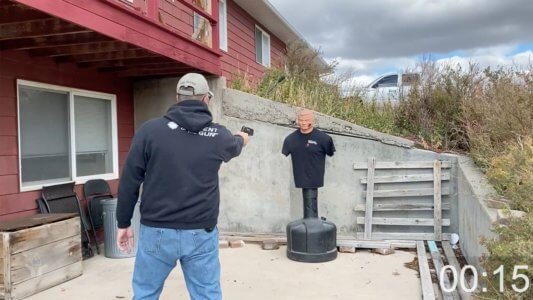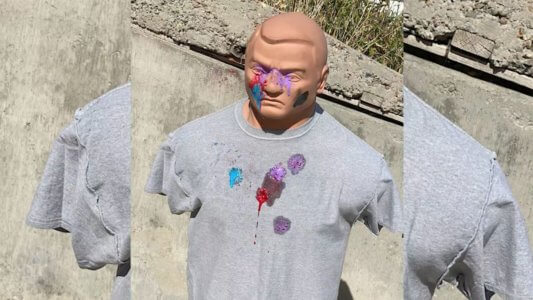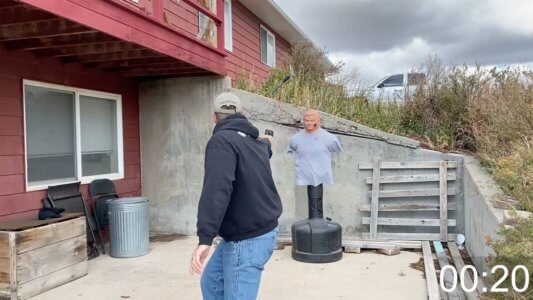Navigate This Post
“Why did you have to shoot him?” or “Why didn’t you give him time to surrender?” Both of these questions are posed by the ignorant and hostile after a law enforcement or self-defense shooting. To the uneducated or uninitiated, the previous inquiries might seem to be valid.
However, to those who have been trained properly and who understand action versus reaction and the concept of reactionary gap, those questions are dangerously naive at best and grossly stupid at worst. During this review, we will consider reactionary gap and action vs reaction and how they apply to life and death scenarios.

GET OUR FREE WEEKLY NEWSLETTER
Reactionary Gap
In the most simplest of terms, reactionary gap means the time between when a stimulus is realized or perceived and the body reacts to the stimulus. One of the best, most practical examples comes from defensive driving school.
If you are driving your car and an object suddenly appears in the road; deer, car tire, fallen tree limbs, etc. the time from when you eyes see the object, and your brain gives your foot the command to hit the brake pedal is generally about 0.50 seconds. If you are distracted by talking, are looking down at the radio, etc. the reactionary gap increases to 0.75 or 1 second or even more depending on the distraction.
Of course, the faster your car is moving the greater distance it will cover even after the brake is applied. During Defensive Driving courses we are taught how far away or how large of a gap we need to leave between our car and the one in front of us. This is all based upon physics with the human reaction time being the variable factor.
Action vs Reaction in a Deadly Force Encounter
Though the subjects are different, we can apply the lessons of reactionary gap in a car to a self-defense shooting scenario. Just like the driving example, in a lethal force encounter, you are reacting to an unexpected stimulus. The attacker is acting and you as the defender are reacting.
As frustrating as reality might be, the person who initiates the action ALWAYS has the advantage, at least initially. That’s why the person who throws the first punch more often than not lands it. Unless you are anticipating and ready to block the punch you are going to get hit before you can stop it. That is the reactionary gap in practice.
The average person with good vision and unhindered nerve and muscle control can react to an unexpected stimulus, if they are paying attention, in about 0.50 seconds. Conversely, the reaction to an anticipated stimulus for the same person is only about 0.25 seconds. However, you have to know or at least anticipate that the stimulus is coming.
Let’s Consider Average Draw Speeds
From both the secure duty holster and the concealed holster, draw speed will vary. From my experience as a trainer, the average police officer can, when given an expected stimulus; beeper, whistle, voice command, etc., draw from their duty holster and fire 2 shots in just under 2 seconds.
This, of course, is after training, practice and anticipating the command to fire. For the concealed carry holster where a cover garment must be moved away, trained shooters will average 3 to 4 seconds for the same 2 shots under the same scenario.
The missing factor in the above discussion is the reactionary gap or having to react to someone else’s action. Keep in mind, if you are talking, engaging in some kind of task (using your hands) or are distracted by external stimuli, the gap climbs from 0.50 seconds to 1 second or more.
I understand that some of you might be underwhelmed or unimpressed by the discussion of factions of seconds. “Big deal.” you might say, “I can draw from my holster and fire a shot in 0.95 seconds.” That is great. Now let’s consider some real times for a person holding a gun to get off a shot from 3 meters or about 10 feet.

Real Time Testing
For the practical testing section I decided to use a new product; a .50 caliber paintball gun from Umarex called the TR50. The gun holds 6 paintballs in a round disc and works just like any DA revolver. The power source is a 12g. CO2 powerlet. These tools fire paintballs about 350 feet per second. I enlisted my longtime training partner “Bob” to be my target.
Next, I set up the video camera and paced off about 10 feet or 3 meters away from Bob. Using the new paintball gun I ran through different scenarios where I was the aggressor. I started with the gun in hand down by my side, turned 90 degrees to the right and 90 degrees to the left. Then I turned around so that I had to turn 180 degrees to get off a shot. I also held the gun behind my back as well as the hands up facing and hands up 180 degree turn.
Rather than use a shot timer, I had my editor pull the times from the video from the moment I start to move until the shot breaks. Naturally, I fired numerous shots from each position. What I have listed below is the average times for each scenario.
One Shot on Target from 3 meters / 10 feet Time measured in seconds
- Facing straight on- 0.50
- 90º Left (gun in right hand) – 0.48
- 90º Right (gun in right hand) – 0.50
- 180º Turn – 0.70
- Gun Behind Back – 0.60
- Hands Up facing – 0.70
- Hands Up 180º Turn – 0.75
As you can see, from the above details, it never even took one full second to get off a shot on target, even facing away 180º, the longest time gap was ¾ of a second. If we return to the opening paragraph of this piece and the “Why did you shoot?” or “Why didn’t you give him a chance to surrender?” This is why. In the real world, in a self-defense shooting scenario, a person holding a gun that is inside of 5 yards can kill you in under 1 second.
If your gun is holstered and an attacker with a gun already in hand decides to shoot you, it is a physical impossibility for you to react, draw your gun, and shoot them before you have already been shot, likely multiple times. If you have your gun out but pointed at the ground, the best you can hope for is to fire as they are firing. In gunfights, you lose all ties.
The only way to win in these scenarios would be to have your gun pointed at the threat and to be anticipating their action. In such a case, you have about a 0.25 to 0.50 advantage.

Training and Experience
I have undertaken Force on Force training for over 30 years now. During my first experience, I got “shot” an embarrassing number of times and had the paint marks and quarter-sized bruises to show for it. You know what? That was a good thing. It is far better to be a bit embarrassed and bruised in training than to go out into the real, dangerous world unprepared.
If you are carrying a firearm for self-protection you owe it to yourself and to your family to seek out some type of realistic Force on Force training where you must complete, not against cardboard and a shot timer but, against real, unpredictable people. The life you save may not be just your own, but those who are counting on you to protect them.
Action vs. Reaction: How Fast Can a Bad Guy Shoot You [Video]
Professor Paul Markel
Latest posts by Professor Paul Markel (see all)
- Tactical Rifle Tips: Transition Drills - January 5th, 2024
- 40/20/25 Shooting Drill - October 29th, 2023
- Working With Your Body Armor - October 3rd, 2023
- Hi-Point YC9: Yeet Cannon - August 14th, 2023
- Texas Hog Hunting: Day or Night w/ One Rifle - July 25th, 2023
Recent Comments